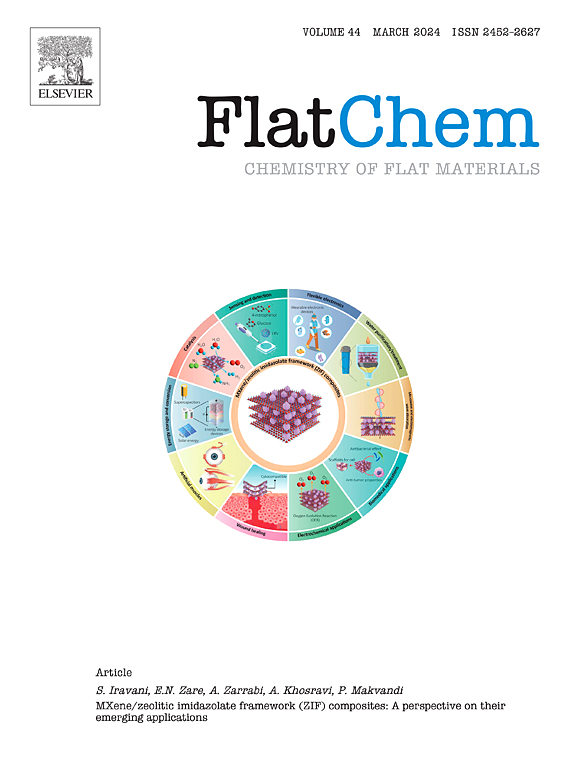Highly sensitive voltammetric detection of 4-nitrobenzoic acid using Zn2SnO4/porous graphene oxide nanosheets composite electrode
IF 6.2
3区 材料科学
Q2 CHEMISTRY, PHYSICAL
引用次数: 0
Abstract
Detecting 4-nitrobenzoic acid (4-NBA) is crucial due to its prevalence as an industrial pollutant and associated health hazards. In this study, we synthesized a novel stannate-based nanocomposite, Zn2SnO4/porous graphene oxide nanosheets (Zn2SnO4/PGO), through a facile hydrothermal method followed by ultrasonication-assisted dispersion. For the first time, this Zn2SnO4/PGO nanocomposite was employed as an electrode modifier for 4-NBA detection. The structural and physicochemical properties of the synthesized Zn2SnO4/PGO nanocomposite were systematically characterized using various spectroscopic techniques. Electrochemical studies, including electrochemical impedance spectroscopy (EIS), cyclic voltammetry (CV), and differential pulse voltammetry (DPV), demonstrated that the Zn2SnO4/PGO-modified electrode has a significantly enhanced electroactive surface area and efficient electron transport, resulting in superior electrocatalytic activity for 4-NBA detection. From the DPV quantification experiments, the limit of detection was calculated as 3.3 nM within the linear detection range of 0.1–231 μM. The sensor demonstrated high accuracy, repeatability, reproducibility, and long-term stability. Anti-interference studies indicated no significant cathodic potential shifts in the presence of common interfering species. Finally, the Zn2SnO4/PGO-modified sensor was successfully applied to detect 4-NBA in real samples, including human urine, river water, and wastewater, showing excellent recovery rates. These findings confirm the sensor's potential for reliable and sensitive electrochemical monitoring of 4-NBA in different matrices, underscoring the importance of environmental safety and public health protections.

zno /多孔氧化石墨烯纳米片复合电极对4-硝基苯甲酸的高灵敏度伏安检测
检测4-硝基苯甲酸(4-NBA)是至关重要的,因为它是一种普遍存在的工业污染物和相关的健康危害。在这项研究中,我们合成了一种新的锡酸盐基纳米复合材料,Zn2SnO4/多孔氧化石墨烯纳米片(Zn2SnO4/PGO),通过简单的水热法和超声辅助分散。该纳米复合材料首次被用作4-NBA检测的电极修饰剂。利用各种光谱技术对合成的Zn2SnO4/PGO纳米复合材料的结构和物理化学性质进行了系统表征。电化学研究(包括电化学阻抗谱(EIS)、循环伏安法(CV)和差分脉冲伏安法(DPV))表明,Zn2SnO4/ pgo修饰电极具有显著增强的电活性表面积和高效的电子传递,从而提高了4-NBA检测的电催化活性。通过DPV定量实验,在0.1 ~ 231 μM的线性检测范围内,计算出检测限为3.3 nM。该传感器具有高精度、可重复性、再现性和长期稳定性。抗干扰研究表明,在常见干扰物质存在的情况下,阴极电位没有显著变化。最后,将Zn2SnO4/ pgo修饰传感器成功应用于实际样品(包括人尿、河水和废水)中4-NBA的检测,显示出良好的回收率。这些发现证实了该传感器在不同基质中可靠和敏感的电化学监测4-NBA的潜力,强调了环境安全和公共健康保护的重要性。
本文章由计算机程序翻译,如有差异,请以英文原文为准。
求助全文
约1分钟内获得全文
求助全文
来源期刊

FlatChem
Multiple-
CiteScore
8.40
自引率
6.50%
发文量
104
审稿时长
26 days
期刊介绍:
FlatChem - Chemistry of Flat Materials, a new voice in the community, publishes original and significant, cutting-edge research related to the chemistry of graphene and related 2D & layered materials. The overall aim of the journal is to combine the chemistry and applications of these materials, where the submission of communications, full papers, and concepts should contain chemistry in a materials context, which can be both experimental and/or theoretical. In addition to original research articles, FlatChem also offers reviews, minireviews, highlights and perspectives on the future of this research area with the scientific leaders in fields related to Flat Materials. Topics of interest include, but are not limited to, the following: -Design, synthesis, applications and investigation of graphene, graphene related materials and other 2D & layered materials (for example Silicene, Germanene, Phosphorene, MXenes, Boron nitride, Transition metal dichalcogenides) -Characterization of these materials using all forms of spectroscopy and microscopy techniques -Chemical modification or functionalization and dispersion of these materials, as well as interactions with other materials -Exploring the surface chemistry of these materials for applications in: Sensors or detectors in electrochemical/Lab on a Chip devices, Composite materials, Membranes, Environment technology, Catalysis for energy storage and conversion (for example fuel cells, supercapacitors, batteries, hydrogen storage), Biomedical technology (drug delivery, biosensing, bioimaging)
 求助内容:
求助内容: 应助结果提醒方式:
应助结果提醒方式:


